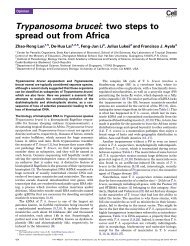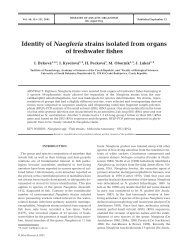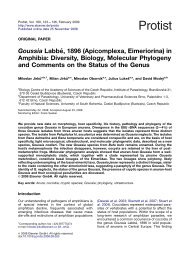Translational initiation in Leishmania tarentolae and Phytomonas ...
Translational initiation in Leishmania tarentolae and Phytomonas ...
Translational initiation in Leishmania tarentolae and Phytomonas ...
You also want an ePaper? Increase the reach of your titles
YUMPU automatically turns print PDFs into web optimized ePapers that Google loves.
2 J. Lukeˇs et al. / Molecular & Biochemical Parasitology xxx (2006) xxx–xxx<br />
Consensus sequences have been postulated for the start codon<br />
context of a representative number of genes <strong>in</strong> several eukaryotic<br />
organisms such as yeast [9], Chlamydomonas [10], plants <strong>and</strong><br />
fungi [11]. These sequences appear to be species specific, s<strong>in</strong>ce<br />
the consensus nucleotides <strong>in</strong> different sites vary from species<br />
to species. However, some features of the 5 ′ adjacent region of<br />
the AUG seem to be of universal importance, <strong>in</strong> particular the<br />
occurrence of a pur<strong>in</strong>e nucleotide, mostly aden<strong>in</strong>e, at the −3<br />
position [12].<br />
Among lower eukaryotes, k<strong>in</strong>etoplastid flagellates are notorious<br />
for f<strong>in</strong>d<strong>in</strong>g unique solutions to general processes of the<br />
eukaryotic cell. One of them is the virtual lack of transcriptional<br />
control, with regulation of abundance of mRNA <strong>and</strong> prote<strong>in</strong><br />
operat<strong>in</strong>g primarily at the post-transcriptional level [13]. Studies<br />
of mRNA levels derived from chromosomes 1 <strong>and</strong> 3 of <strong>Leishmania</strong><br />
major <strong>in</strong>dicate that transcription by RNA polymerase II<br />
(Pol II) <strong>in</strong>itiates bidirectionally from a s<strong>in</strong>gle region, generat<strong>in</strong>g<br />
two polycistronic primary transcripts conta<strong>in</strong><strong>in</strong>g dozens<br />
of genes [14,15]. The transcription of only few large polycistronic<br />
transcripts strongly biases regulation towards the posttranscriptional<br />
level. Such regulation may <strong>in</strong>volve cap addition,<br />
almost exclusively trans-splic<strong>in</strong>g, nucleocytoplasmic export, 3 ′<br />
end process<strong>in</strong>g, mRNA decay <strong>and</strong> f<strong>in</strong>ally translational <strong><strong>in</strong>itiation</strong><br />
<strong>and</strong> elongation [13,16,17].<br />
On a limited set of 100 genes, it was recently shown that<br />
the pre-ATG triplet <strong>in</strong> <strong>Leishmania</strong> has a G/ACC bias, which is<br />
similar to that of vertebrates [18]. This to an extent conflicts<br />
with an earlier study of flagellated protozoans show<strong>in</strong>g a very<br />
low degree of conservation around AUG with the consensus<br />
sequence WNNNNNANNaugNC [19]. Another study suggested<br />
that pre-ATG triplets can <strong>in</strong>fluence the level of prote<strong>in</strong> expression<br />
<strong>in</strong> <strong>Leishmania</strong> by several orders of magnitude [20].<br />
In addition to the importance for underst<strong>and</strong><strong>in</strong>g gene expression<br />
mechanisms <strong>in</strong> K<strong>in</strong>etoplastida, the knowledge of sequences<br />
required for efficient translational <strong><strong>in</strong>itiation</strong> could provide useful<br />
tool for manipulation of the expression levels of homologous<br />
<strong>and</strong> heterologous genes <strong>in</strong> these organisms. To experimentally<br />
<strong>in</strong>vestigate the <strong>in</strong>fluence of the pre-ATG triplets on translation<br />
<strong>and</strong> overall prote<strong>in</strong> expression <strong>in</strong> trypanosomatid flagellates, we<br />
undertook an exhaustive <strong>in</strong> vivo analysis us<strong>in</strong>g enhanced green<br />
fluorescent prote<strong>in</strong> (EGFP) as a reporter prote<strong>in</strong>. We observed<br />
a strong effect on translational efficiency <strong>and</strong> a similar impact<br />
of specific pre-ATG triplets <strong>in</strong> flagellates <strong>Leishmania</strong> <strong>tarentolae</strong><br />
<strong>and</strong> <strong>Phytomonas</strong> serpens. We demonstrate that the different<br />
prote<strong>in</strong> expression pattern observed with different target genes<br />
resulted from a complex <strong>in</strong>terplay of the pre-ATG triplet <strong>and</strong> the<br />
cod<strong>in</strong>g sequence, possibly reflect<strong>in</strong>g the <strong>in</strong>fluence of the secondary<br />
structure of the cod<strong>in</strong>g part of mRNA on translational<br />
<strong><strong>in</strong>itiation</strong>.<br />
2. Materials <strong>and</strong> methods<br />
2.1. EGFP plasmid construction<br />
The library of expression plasmids with r<strong>and</strong>omized<br />
pre-ATG nucleotides was prepared by PCR amplification of<br />
the EGFP-N1 gene (Invitrogen) with forward primer 882<br />
(ACAGCAGCCAGATCTNNNATGGCTCGAGCGATGGTG-<br />
AGCAAGGGCGAGGAGCTG) <strong>and</strong> reverse primer 524<br />
(AGGAGGAGGGCGGCCGCTTTA). The EGFP start codon<br />
is underl<strong>in</strong>ed <strong>and</strong> the pre-ATG triplet is <strong>in</strong> bold. The result<strong>in</strong>g<br />
PCR products were trimmed with restriction enzymes BglII<br />
<strong>and</strong> NotI <strong>and</strong> <strong>in</strong>serted <strong>in</strong>to the <strong>Leishmania</strong> expression vector<br />
p F4X1.4sat (Jena Bioscience) open with the same enzymes<br />
[21]. The obta<strong>in</strong>ed E. coli clones were screened for the <strong>in</strong>dividual<br />
pre-ATG triplets by sequenc<strong>in</strong>g of the recomb<strong>in</strong>ant plasmids.<br />
Due to the nucleotide bias <strong>in</strong> the obta<strong>in</strong>ed library, second <strong>and</strong><br />
third rounds of plasmid construction were performed with forward<br />
primers 1160 (ACAGCAGCCAGATCTCNVATGGCT-<br />
CGAGCGATGGTGAGCAAGGGCGAGGAGCTG), 1161 (A-<br />
CAGCAGCCAGATCTADNATGGCTCGAGCGATGGTGA-<br />
GCAAGGGCGAGGAGCTG), 1162 (ACAGCAGCCAGATC-<br />
TGDNATGGCTCGAGCGATGGTGAGCAAGGGCGAGGA-<br />
GCTG), or 1163 (ACAGCAGCCAGATCTTHVATGGCTCG-<br />
AGCGATGGTGAGCAAGGGCGAGGAGCTG) <strong>and</strong> 1316 (G-<br />
CCAGATCTCAAATGGCTCGAGCGATGGTGAGCAAGG-<br />
GCGAGGAGCTG), 1317 (GCCAGATCTCGCATGGCTCG-<br />
AGCGATGGTGAGCAAGGGCGAGGAGCTG), 1318 (GCC-<br />
AGATCTCGGATGGCTCGAGCGATGGTGAGCAAGGGC-<br />
GAGGAGCTG), 1319 (GCCAGATCTGACATGGCTCGAG-<br />
CGATGGTGAGCAAGGGCGAGGAGCTG), 1320 (GCCAG-<br />
ATCTTCAATGGCTCGAGCGATGGTGAGCAAGGGCGA-<br />
GGAGCTG), or 1321 (GCCAGATCTTACATGGCTCGAGC-<br />
GATGGTGAGCAAGGGCGAGGAGCTG) designed to produce<br />
miss<strong>in</strong>g triplets. After all 64 possible pre-ATG triplets were<br />
obta<strong>in</strong>ed, the sequence of the entire EGFP gene was confirmed<br />
for each clone. The result<strong>in</strong>g plasmids were l<strong>in</strong>earized with<br />
SwaI <strong>and</strong> used for transfection of <strong>Leishmania</strong> <strong>and</strong> <strong>Phytomonas</strong><br />
cells.<br />
Genomic <strong>in</strong>tegration of the plasmids <strong>in</strong>to the SSU locus was<br />
confirmed by diagnostic PCR with primer F2999 (CCTAGTAT-<br />
GAAGATTTCGGTGATC) anneal<strong>in</strong>g <strong>in</strong>side the expression cassette<br />
<strong>and</strong> primer F3002 (CTGCAGGTTCACCTACAGCTAC)<br />
anneal<strong>in</strong>g to the SSU rRNA sequence not present on the plasmid.<br />
2.2. TET-R <strong>and</strong> dsRED plasmid construction<br />
To obta<strong>in</strong> the pre-ATG variants of the tetracycl<strong>in</strong>e repressor<br />
(TET-R) gene, its cod<strong>in</strong>g sequence was amplified by PCR<br />
with forward primers 1496 (TAATAAAGATCTATCATGTC-<br />
TAGATTAGATAAA AGTAAAGTG), 1497 (TAATAAAGAT-<br />
CTACCATGTCTAGATTAGATAA AAGTAAAGTG), 1498<br />
(TAATAAAGATCTTCGATGTCTAGATTAGATAA AAGTA-<br />
AAGTG), 1499 (TAATAAAGATCTCCAATGTCTAGATTAG-<br />
ATAA AAGTAAAGTG), <strong>and</strong> A263 (ACGCGTACACAACA-<br />
CACGGAC) as a reverse primer, us<strong>in</strong>g pF4TR1.4hyg as a template<br />
[22]. The PCR products were digested with BglII <strong>and</strong> NotI<br />
<strong>and</strong> subcloned <strong>in</strong>to pF4X1.4hyg vector digested with the same<br />
enzymes.<br />
For construction of pre-ATG variants of the red fluorescent<br />
prote<strong>in</strong> dsRED gene, its cod<strong>in</strong>g sequence was PCR amplified<br />
with primers 1570 (TAATAAGCTCGAGCGATGAGGTCTTC<br />
CAAGAATGTTATCAAGG) <strong>and</strong> 1571 (TAATAAGGCGGC-








